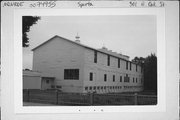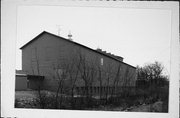| Additional Information: | Rectangular openings - mostly filled in; cupola; attached to modern building front on Oak Street.
This warehouse was constructed in 1920 and was part of the Jefferson Leaf Tobacco Company's operations.
The roots of the Jefferson Leaf Tobacco Company began in 1903, when A.H. Merrill started a tobacco warehouse in Sparta, which employed a number of people in packing and stripping tobacco. In 1909, this operation was reorganized and incorporated by W.T. Jefferson, his son Harley W. and several other individuals. W.T. Jefferson had been the former manager of the American Tobacco Company and had considerable experience in the tobacco industry in Virginia and in Wisconsin. W.T. Jefferson called the new business the Jefferson Leaf Tobacco Company and immediately secured the Shattuck lumber yard property on East Oak Street (not extant) for the business. At this location, the Jefferson Leaf Tobacco Company conducted their business of buying and selling tobacco on a large scale. Associated with this business were a number of warehouses where the drying, grading, sorting took place. At first, the Jefferson Leaf Tobacco Company leased warehouses off South Water Street (location unknown), where approximately fifty to one hundred seasonal workers handled the tobacco. By 1920, they had completed the large warehouse standing today at 301 East Oak Street. This warehouse was located next to the O.I. Newton residence (not extant) which was later used as an office for the tobacco company. The initial officers of the corporation were W.T. Jefferson (President), D.W. Cheney (Vice-President) and H.W. Jefferson (Secretary and Treasurer). By the 1920, the company grew to the point that it also had a large branch in Black River Falls and also built an office building at 115 West Oak Street (MP 37/2).
By 1933, the Jefferson Leaf Tobacco Company processing warehouse in Sparta were still going strong, and Sparta continued as a center for a tobacco processing for sometime thereafter.
The Jefferson Tobacco Warehouse gains local historical significance under Criterion A in association with the Miscellaneous Small Businesses and Light Industries of the Industry Theme. At the turn of the century, the Sparta region had become an important tobacco leaf producing area and it was not long before several tobacco leaf processing plants opened up in Sparta. The Jefferson Leaf Tobacco Company was one of two prominent companies of this nature in Sparta. This building is one of the last remainders of that economic enterprise which influenced the growth of Sparta. The building's period of significance ranges from its erection and initial business occupation in 1920 to at least 1933.
This large two-story iron-clad frame warehouse is a gabled roofed building form that is constructed on an elevated concrete foundation. It features plain rectangular window openings, most of which are filled with wooden panels, and cupola on the roof.
Originally, this large warehouse was attached to the rear of the historic Newton House that was remodeled during the same period to serve as the Jefferson Tobacco Company office. Presently it is attached to a contemporary styled commercial building fronting on East Oak Street.
This utilitarian appearing warehouse was constructed in 1920 for the Jefferson Tobacco Company on property they purchased the year before from the Newton family. This warehouse, 55 ft x 196 ft, contained a sorting room for 150 workers on the upper floor, storage on first floor, a packing room in the basement and baths for women workers on the first floor. Established in 1909, the Jefferson Company also had a similar but smaller warehouse (MO34/15) built earlier in 1917 located west (across Beaver Creek) of the large 1920 warehouse.
The Jefferson Tobacco Warehouse does not meet the NRHP criteria for architectural significance because of a lack of integrity. However, this building has sufficient architectural character to meet the criteria for historical significance. A better preserved representative of the Jefferson Company is the iron-clad warehouse located at East Oak and South Spring Street (MO34/15). |
|---|
| Bibliographic References: | (A) Sparta Herald Nov. 23, 1920.
(B) Sanborn Insurance Maps 1900, 1911, 1922, 1931.
(C) Randolph A. Richards, History of Monroe County, Wisconsin: Past and Present, Including an Account of the Cities, Towns and Villages of the County. Chicago: C.F. Cooper and Co., 1912, pp. 284 and 323.
(D) Gregory, John G., West Central Wisconsin: A History. Vol. 3, Indianapolis: S.J. Clarke Publishing Company, 1933, pp. 197, 215-216; Vol. 2, p. 854.
(E) Koehler, Lyle P., From Frontier Settlement to Self-Conscious American Community: A History of One Rural Village (Sparta, Wisconsin) in the Nineteenth Century. Evansville, Indiana: Unigraphic, Inc., 1977, p. 96.
(F) Jones, Ida Lucille, "A History of Sparta, Wisconsin." B.A. Thesis. University of Wisconsin, 1915, pp. 10, 11.
(G) Monroe County Democrat July 20, 1933. |
|---|


